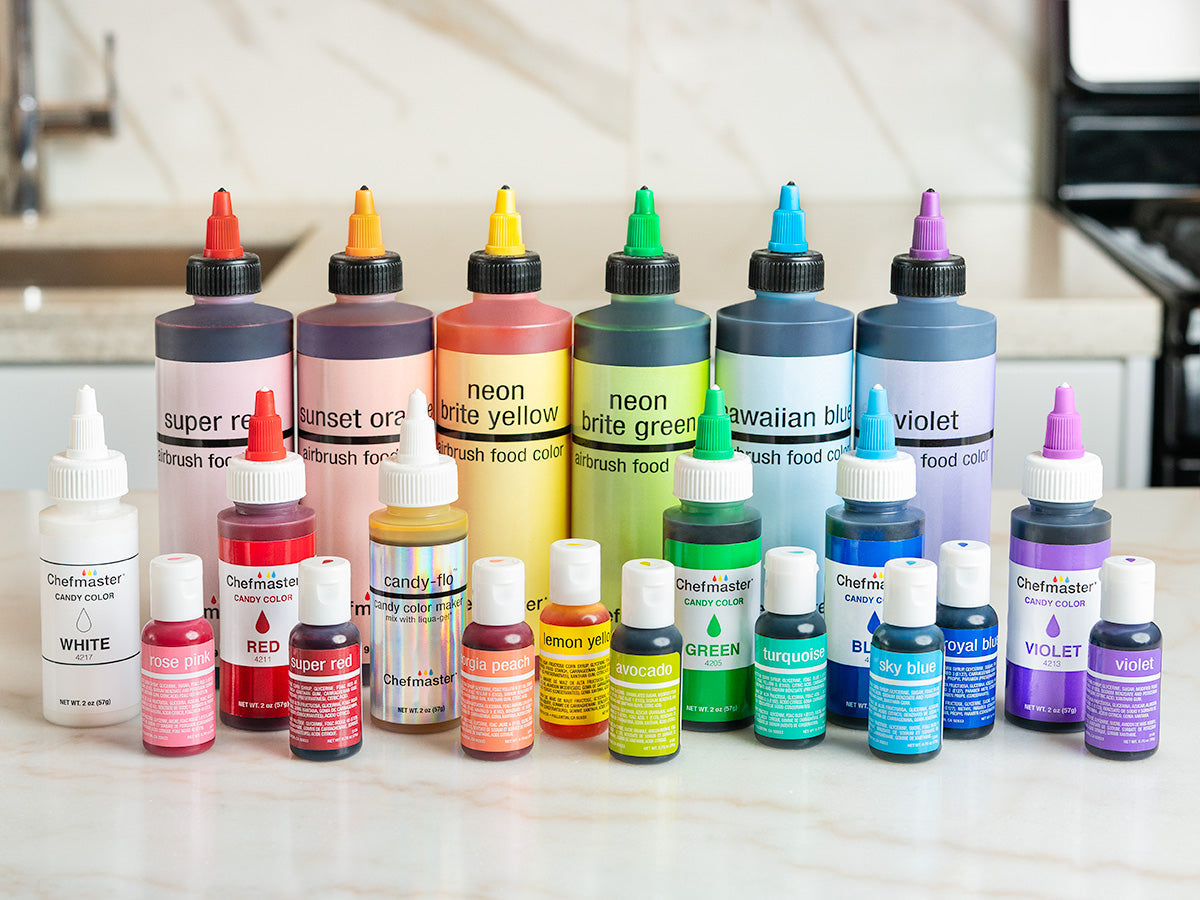WHAT ARE THE DIFFERENT TYPES OF FOOD COLORING?

At one point or another of our baking and decoration journey, we have all ended up with cake batter a few shades too dark, icing colors bleeding or colored coating chocolate separating. The common reason behind all these mistakes is often that we either used the wrong type of food coloring or used the right food coloring incorrectly. All these colorful bottles and jars can get pretty confusing. Lucky for you we are food coloring expert, so let us guide you through the various types of colors and their usage.

Liquid Food Coloring
Typically found in supermarkets and grocery stores this type of food coloring is often the cheaper, but it is also the less concentrated type of food coloring you can find.
Liquid coloring is traditionally made using a water base and synthetic coloring in low concentration. It is watery and will require you to add a significant amount of food coloring into your base if you want to achieve a vibrant, rich or dark color. This will thin out your texture and more often than most create some drying and color bleeding issues. It is a good choice if you wish to achieve pastel colors in icing or batter or to use in other liquid mediums such as syrup, water, alcohol, etc.
Liquid Gel Food Coloring
Liquid Gel food coloring is also water based, but often contains glycerin and/or corn syrup in addition to synthetic coloring. It has a semi-thick gel texture and is a more concentrated form of food coloring. This type of food coloring is commonly used by professional Pastry Chefs, Cake Decorators and Cookiers. Customers can often be found in the bakery aisles of their favorite craft stores, in cake decorating supplies stores or online. When using Liquid Gel food coloring for the first time, you will notice a significant difference in concentration compare to Liquid food coloring. Start adding your Liquid Gel food coloring to your medium only one drop at the time and mix in between drops until you are familiar with using this type of food color.
Liquid Gel food coloring is a great choice to color all types of bases and mediums in rich, vibrant colors, except coating chocolate and anything fat-based. It also handles heat well and is perfect for batters and other baked applications.
Chefmaster Liqua-Gel® food coloring is one of the highest quality Liquid Gel food coloring available to both professionals and home-bakers.
Gel food coloring
Also referred to as Gel Paste coloring, Gel food color is much thicker than liquid gel food coloring and highly concentrated, resulting in more vibrant, richer, deeper colors. Gel coloring need more time to develop and get deeper. It is important to let your colored mixture rest for at least 15 minutes before adding more color. Gel food colorings are trickier to work with and are primarily used by professionals to color large batches of icing or dough at the time. Home bakers can usually find small jars of Gel food coloring in the bakery aisles of their favorite craft stores, in cake decorating supplies stores or online.
When using Gel food coloring at home it is recommended to use a toothpick to transfer really small amount of coloring in your mixture at the time. Although more expensive than Liquid Gel food coloring and Liquid food coloring, they are well worth the money in the long run as they are highly concentrated and you will need to use less food coloring overall. It might just take you a little longer to adjust to working with this type of food coloring.

Powdered Food Coloring
Powder food coloring is a completely dry form of food dye with no liquid. It is the most concentrated form of food coloring sold to home-bakers and is perfect to use in recipes and applications sensitive to added moisture such as French Macarons and chocolate. Powder food colorings do not mix with water. If your recipe calls for food coloring in a more liquid form it is best to mix them with oil or a fat-based ingredients or dissolve them in a few drops of clear alcohol such as Vodka that will evaporate during baking. When added to a recipe in large amount in its powder form, this type of food coloring might dry out your mix. It is also harder to mix evenly in batter than Liquid Gel food coloring. Always allow the mixture to sit 5 to 10 minutes after incorporating the powdered dye to let the color fully develop.
Powdered food coloring is mostly found online or in specialty stores. Chefmaster offers a complete line of high quality powdered food coloring under its Powder Candy Colors line.
Airbrush Food Coloring
Airbrush food coloring is similar to Liquid Gel food coloring in terms of ingredients, but is characterized by a different, thinner viscosity specially formulated to be used with an airbrush compressor machine. Air brushing is a decorating technique allowing to create realistic painting or watercolor like effects on icing, cookies, and fondant pieces or to cover an entire iced cake. Airbrush guns and airbrush food coloring are mainly sold to professional via decorating distributors or to home-bakers in cake decorating supplies stores and online. They vary greatly in terms of pricing and quality of their mist. It usually takes a couple of tries to master one, but once you do it will open an entire new world of decorating opportunities for your cookies and cakes. Airbrush food coloring will not hold or color chocolate.
Chefmaster offers an extensive line of Airbrush food coloring with top-of-the-line coverage and some of the most beautiful metallic hues available in the market place along with a high-performing Airbrush Cleaner to keep your equipment working like new. We are also one of the rare food coloring manufacturers to offer a professional quality line of Natural airbrush food coloring.

Oil-Dispersible Food Coloring (also known as Candy Colors)
One of the recurring themes you might have noticed in the description of most of the types of food coloring we have discussed so far is that they cannot be used to color coating chocolate or for fat-based applications. You might wonder what to use in these situations. Look no further, Oil-Dispersible food colorings, also referred to as Liquid Candy Color, is the answer to your question. Liquid Candy Color are specifically formulated to bind to oil-based products such as chocolate, candy melts and other fat-based and oil-based applications where adding water would affect the final texture and performance of the product. Liquid Candy Colors can be found in the bakery aisles of their favorite craft stores, in cake decorating supplies stores or online.
Chefmaster offers a high-quality line of Liquid Candy Colors in a variety of sizes.
Natural Food Coloring
Natural food colors have been growing in popularity over the past decade and are made using dyes commonly found in nature. They are the best choice for health-conscious consumers and people with allergies to artificial dyes, but have a relatively low light and heat resistance. As such they are best used for low heat or no heat applications and food products that will not be exposed to harsh lighting for long period of time.
The most common sources of natural dyes per color are:
- Red: Beet, Pomegranate.
- Pink: Raspberry
- Orange: Carrot, Paprika.
- Yellow: Turmeric, Saffron.
- Green: Chlorophyll, Matcha, Spinach, Parsley.
- Blue: Purple Cabbage, Spirulina
- Purple: Blueberry, Purple Carrots, Ube, Acai
- Brown: Coffee, Cocoa, Cinnamon
- Black: Activated Charcoal, Squid Ink, Black Cocoa.
Natural food coloring can be found both in powder and liquid form. It is recommended to store both forms in cool, dark place away from any heat and sunlight.
- Powdered natural food coloring usually come in small pouches or packets. They are less light stable than their liquid gel equivalents and often fade in less than 24 hours when exposed to sunlight, making natural Liquid gel food coloring a better choice for decorating.
- Natural liquid gel food coloring is water based and often contains glycerin like its artificial counterpart. It is more light-resistant than powder and mess-free to use.
- Natural airbrush food coloring is water based and specifically designated to use with an airbrush gun.
Both our Natural Liqua-Gel® food coloring line and our Natural Airbrush food coloring line have been specifically formulated to offer better light stability and holding their colors better than other natural food colorings available in the market.
DOWNLOAD PDF
